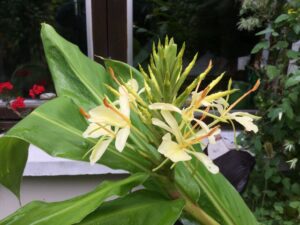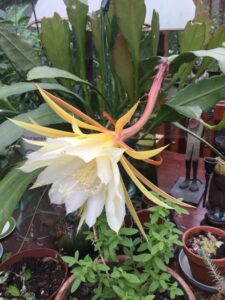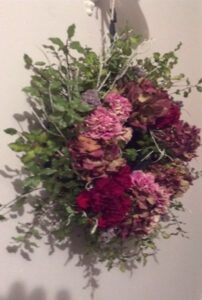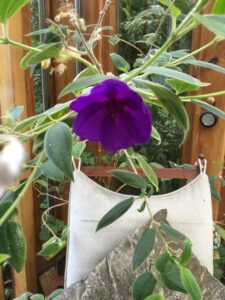DECEMBER AND JANUARY IN OUR GARDENS – Philippa Thomas
December sees the shortest day of the year, Winter officially begins on December 21st. Really, there is a beginning, a middle and an end to winter, each of these ‘mini- seasons’ lends itself to different plants with different levels of interest. THIS QUIET SEASON OFFERS A SUBTLE BEAUTY ALL OF ITS VERY OWN, LITERALLY WAITING TO BE EMBRACED. One of the easiest ways to liven up our winter landscape is with plants that glisten during our colder months. Special plants strategically selected and placed will give a magnificent landscape that will look superb in all four seasons.
With our cold weather settling in, many of us are lighting fires and donning our chunky knits but remember, the coldest weather can generally bring calmer and drier conditions….Then, on the other hand, we may have biting cold winds and even though much of our flora and fauna are fast asleep, we Gardeners have a long list of jobs to keep us busy. Winter is here to stay for a while, (or so we assume, despite our global warming.) For some, it is a welcome break to working outdoors…..Let’s take this precious time to enjoy the winter scents in our gardens, Daphne Odora Marginata and Sarcococca, (Christmas Box,) are presently divine. – It’s worth putting a few sprigs into a vase to scent a room….
Unsurprisingly, the best garden ideas are achieved by careful winter garden planning. Really, it creates the backbone, the structure to a garden and is especially important in winter, our evergreen plants, climbers and shrubs play a leading role. Plants with colourful bark and stems really do come into their own especially when planted en masse for maximum impact. If we have space , Dogwoods are stunning, their colourful winter stems range from yellow and gold through bright orange, red and purple. So, let’s make the most of daylight hours by getting bare root plants into the ground and let’s take some hardwood cuttings. Virginia Creeper and Boston Ivy, both these self- clinging climbers are wonderful for autumn colour however, once their leaves have fallen, it’s a good opportunity to cut back any parts that are starting to overextend their reach, …..left untrimmed, they can swamp supports and settle into guttering causing damage.

Ginger, Hedychium, Maybe Flavum, Flowering In Late November…..
If we grow as many trees, climbers and shrubs as we possibly can, our local birds will repay our kindness. During the breeding season, birds, even those that normally eat seeds as adults, need staggering numbers of insects to raise their young. The best way to provide them is to grow as many trees, shrubs and climbers. Maybe, invest in some bird feeders and a winter bath…., it’s a great way to enjoy the outdoors even from the comfort of our houses. Then, placing some small lanterns in our borders makes our gardens seem a little more magical and they work especially well against the reflection of a conservatory. ALTERNATIVELY, WE CAN SPICE UP THE COUNTDOWN TO CHRISTMAS BY CREATING AN ADVENT SCAVENGER HUNT IN THE GARDEN. Maybe, hide packets of seeds, wrapped sweets or tiny parcels in the garden. Colourful bunting, garlands, balloons and hanging decorations can quickly turn a garden into a funky festival.

Epiphyllum, Queen Of The Night In Glass Room, It’s Scent, Simply Divine At Night
CHRISTMAS AND OUR NEW YEARS 2023 WREATHS
A wreath on our front door is a holiday classic. The practice of hanging a wreath on the front door dates all the way back to Roman times when they symbolised victory. The word wreath comes from writ-hen, an old English word meaning to twist. Why not make a frame and decorate it with greenery, baubles, dried flowers or seasonal berries. For a gorgeously scented option, maybe create a wreath from Lavender, Rosemary or Bay Laurel. We can even delight our guests with a wreath made of dried herbs with a sumptuous aroma. We can position wreaths throughout our gardens, along fences, on gates, lamp posts, at the base of planters etc. FESTIVE WREATHS AND NEW YEARS WREATHS CAN BE INEXPENSIVE AND FUN TO MAKE, EARTHY AND WHIMSICAL .
Hardy and different textured foliage such as Spruce, Buxus, Evergreen Oak, Privet, Dried Oranges, Dried Limes, Cinnamon Sticks all look great and create a delicious festive aroma. Softer, evergreen foliage also works well as fillers for creating the bulk of the wreath, so too is sphagnum moss a marvellous filler……We can use wine corks, pine cones, seeds, dried apples, dried lemons, gourds, ribbons, yarn, paper and glitter, silver or gold sprayed fir and holly berries. We can cut evergreen foliage and branches to make festive garlands and wreaths. Ivy, cornus stems, sprigs of holly, birch, eucalyptus, all too, make stunning displays. Using floral wire to fasten greenery and a hot glue gun is most useful. A New Year’s wreath is typically more rustic with natural elements or snowy or icy blue, jewel-like bits and pieces.

Pittosporum, Especially When Conditioned, With Dried Hydrangeas Make Such A Festive, Homely New Years Wreath
HOUSEPLANTS
Houseplants have a number of benefits in our homes. Indoor plants can improve our health and sharpen our focus, especially those displayed in an office or a classroom etc. Almost all our houseplants have one thing in common, they all need sunshine but each plant will differ in the amount that they will need. Let’s just not place our indoor plant without a thought just because the plant suits our decor. Let’s think about which room gets the most sunlight, which direction do our windows face…? Where are our heaters ? What is the average temperature in our houses ? This way we will know which areas work best when situating our plants. \
Some plants thrive in sunshine, some need partial or full shade for most of the time. Most plants will be happy with a window that is either West, East or South facing. Some plants detest facing a Northerly window. Flowering and foliage plants such as some varieties of ferns tend to deal with minimal direct sunlight and with artificial light. So if we can place our foliage plant back from our south facing window a few feet, we will be putting our plant in an ideal position. Plants with large, fleshy leaves tend to do well in the shade, i.e. Jade, Aloes, The Snake Plant, Mistletoe Cactus, (Rhipsalis,) etc.

Cobea Scandens, Cup And Saucer Climber, ( grown from seed,) And Rhipsalis, just before our freezing weather
GROUND BREAKING NEWS
R H S Scientists have recorded the first rockrose, prickly leaf beetle, found in The UK. If there, it undoubtedly will be here shortly, it was identified on a rock rose, Cystis.
A variegated Aeonium that dates back to 1699 has been identified. Needless to say, it is being protected for our future.
Sphagnum Moss Trials
Not sure……What do you think about This….? Sphagnum moss decays in water logged soil to form peat, however the live peat might one day be used as a replacement for it as it shares many of the desirable characteristics including the way it holds water.
A new research project is looking at ways of optimising production by growing it in a greenhouse. This would speed up harvest from 3-5 years outdoors to 1/2 years undercover which would also keep it sterile and free from pests and diseases.
MIGHT DO, MAYBE DECEMBER JANUARY JOBS
- Bring tender pot plants and dahlia tubers into the greenhouse and close doors, windows and vents.
- As winter sets in, deciduous fern fronds turn brown and start to look a bit messy, cut them back at the base of the stem and put them in the compost heap. In spring, new croziers will unfurl.
- Store firewood away from houses as insects love to live in wood piles and could make their way indoors if stored right next to our homes.
- Wooden bins usually make better compost than plastic ones because they retain more warmth. Old palettes make fantastic compost / manure.
- If you’re itching to get going, this is a superb time for planting bare rooted roses….
- Maybe, make a snow angel, a great excuse to get away from our TV for a while. A snow angel is made in fresh snow, by lying on one’s back and moving one’s arms up and down and one’s legs from side to side to form the shape of an angel… Always take special care.
- WISHING YOU STRENGTH, PEACE, LOVE AND HOPE THIS CHRISTMAS AND MELODY AND SPIRIT FOR OUR NEW YEAR, 2023.

The Last Flower On Tibonchina Urvilleana, Princess Bush / Glory Bush, This December

